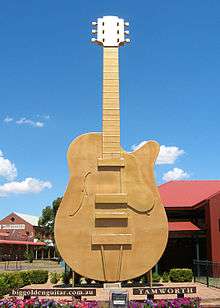Novelty architecture
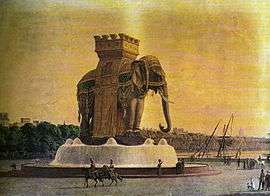
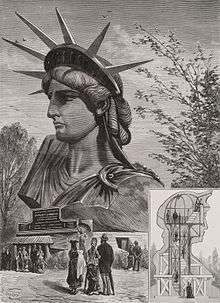
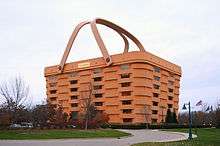
Novelty architecture is a type of architecture in which buildings and other structures are given unusual shapes for purposes such as advertising or to copy other famous buildings without any intention of being authentic. Their size and novelty means that they often serve as landmarks. They are distinct from architectural follies, in that novelty architecture is essentially usable buildings in eccentric form whereas follies are non-usable, ornamental buildings often in eccentric form.
Although earlier examples such as the Elephant of the Bastille exist, generally the style became popular in the United States and spread to the rest of the world as travel by automobile increased in the 1930s.[1] The Statue of Liberty in New York is a replica building that is part sculpture and part monument, which like many subsequent examples of novelty architecture, has an accessible interior and became a tourist attraction.
Constructing novelty architecture near to roads became one way of attracting motorists to a diner, coffee shop, or roadside attraction, so buildings were constructed in an unusual shape, especially the shape of the things sold there. "Mimic" architecture became a trend, and many roadside coffee shops were built in the shape of giant coffee pots; hot dog stands were built in the shape of giant hot dogs; and fruit stands were built in the shape of oranges or other fruit. Tail o' the Pup, mimics a hot dog-shaped hot dog stand; Brown Derby is a derby-shaped restaurant; Bondurant's Pharmacy is a mortar-and-pestle pharmacy; the Big Apple Restaurant, a 10.7 metres (35 ft) and the Big Duck are respectively a tall apple and a (now defunct) poultry store shaped like a duck.
Novelty or programmatic (mimetic) architecture may take the form of objects not normally associated with buildings, such as characters, animals, people or household objects. Lucy the Elephant and The Longaberger Company's head office are examples. There may be an element of caricature or a cartoon associated with the architecture. Such giant animals, fruits and vegetables, or replicas of famous buildings often serve as attractions themselves. Some are simply unusual shapes or constructed of unusual materials.
Many examples of novelty architecture are designed to attract drive-by customers by taking the form of products sold inside. Others, such as casinos in Las Vegas and Macau, are copies of famous landmarks from around the world.
Buildings styled after famous landmarks
Novelty architecture in the form of famous landmarks has been built in China, Georgia, Japan, and the United States. Such replica buildings are extensively used in casinos, hotels or amusement parks such as Disneyland where the apparent playfulness and whimsy are intended to add to their appeal. In some cases, such as Carhenge, the structure is an adaptation of a well-known building.
Casinos on the Las Vegas Strip, in the form of novelty architecture include the pyramid-shaped Luxor Hotel and the New York-New York Hotel & Casino, a building designed to look like the New York City skyline; Paris Las Vegas whose front suggests the Paris Opera House and the Louvre; and Excalibur Hotel and Casino (1990), with its stylized façade of King Arthur's castle (Camelot). In Macau, The Venetian Macao, like its counterpart in Las Vegas, features a replica of St Mark's Campanile and other buildings in Venice.
In Batumi on Georgia's Black Sea coast new high-rise landmark buildings and the renovation of the Old Town have incorporated novelty buildings,[2] including. Many of these constructions are novelty architecture, including the Sheraton Hotel, designed in the style of the Great Lighthouse at Alexandria, Egypt;[3] the Alphabet Tower (145 metres (476 ft) high), celebrating Georgian script and writing; Piazza, a mixed-used development in the form of an Italian piazza; and buildings designed in the style of the Leaning Tower of Pisa, the Acropolis, and an upside-down White House.
In China, the New South China Mall in Dongguan, features a 25 metres (82 ft) replica of the Arc de Triomphe,[4] another replica of Venice's St Mark's Campanile,[5] a 2.1 kilometres (1.3 mi) canal with gondolas,[4] and a 553-meter indoor-outdoor roller coaster.[6] In Japan, there is the Huis Ten Bosch (theme park) near Nagasaki which are replicas of Dutch landmarks like Huis ten Bosch and the Dom Tower of Utrecht.
Water towers and storage tanks
Water towers and storage tanks, often prominent features in a small town, are two types of buildings which have been shaped or decorated to look like everyday objects. There are many versions of these types of novelty architecture.
Water towers exist in many forms, among them peaches; coffee pots and teapots; corn cobs; wine and sauce bottles; fishing bobbers and strawberries.
Several breweries and other businesses have designed holding tanks in the shape of giant cans of beer or other container.
Giant sculptures
Sculptures of ordinary items scaled to building size are another aspect of novelty architecture. Such sculptures appear at roadside parks and attractions or museums in Australia, Canada, Japan, New Zealand, Philippines and the United States. They are likely to represent local animals, such as fish or other wildlife; local plants, such as apples or pineapples; well-known local people such as Paul Bunyan; food, such as the branded candy bars at the former Curtiss Candy Company; sporting or mechanical equipment such as giant bats and balls or tyres; musical instruments, such as guitars; clothes such as giant boots or popular creatures such as dinosaurs.
In some instances, the giant sculpture provides a reference for the building to which it is connected. Examples are the giant baseball bat outside the Louisville Slugger Museum & Factory and the giant "paper" aircraft at Cleveland Hopkins International Airport.
Other styles
Architecture popular in the 1950s-1960s in southern California and in Florida featured sharp corners, tilted roofs, starburst designs, and fanciful shapes. This came to be known as Googie Doo Wop or populuxe architecture.
Long-established firms whose features are well-known could still qualify as novelty architecture. Examples are McDonald's original golden-arches design and the self-referencing design of the White Castle restaurants.
Deconstructivism
Critics of architectural deconstructivism such as Nikos Salingaros, argue that much contemporary architecture is actually Novelty architecture. Leading architects of "the populist, yet the aggressive" forms of Gehry, Libeskind and Hadid reverses architecture's main raison d'etre: to provide viable shelter" and appeal instead to "novelty, excitement and meaningless intellectual acrobatics".[7]
Gallery
Buildings
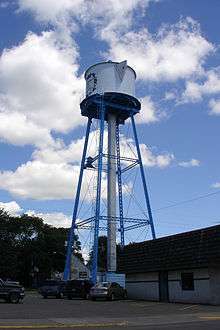 Coffeepot water tower in Lindstrom, Minnesota (1902)
Coffeepot water tower in Lindstrom, Minnesota (1902) The original Brown Derby in Los Angeles, California (1926)
The original Brown Derby in Los Angeles, California (1926)- The Big Duck in Flanders, New York (1931)
 Corn cob water tower in Rochester, Minnesota (1931)
Corn cob water tower in Rochester, Minnesota (1931)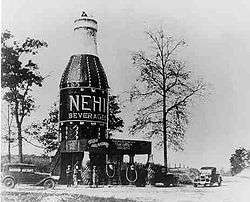 A 64-foot-tall (20 m) Nehi Bottle located near Auburn Alabama (In an area referred to as "The Bottle") (destroyed by fire in 1933)
A 64-foot-tall (20 m) Nehi Bottle located near Auburn Alabama (In an area referred to as "The Bottle") (destroyed by fire in 1933)- Benewah Milk Bottle in Spokane, Washington (1935)
- Bono's Orange Stand in Fontana, California (1936) used to sell California orange juice to hot drivers who all lacked air conditioning at that time.[8][9]
 World's Largest Catsup Bottle water tower in Collinsville, Illinois (1949)
World's Largest Catsup Bottle water tower in Collinsville, Illinois (1949)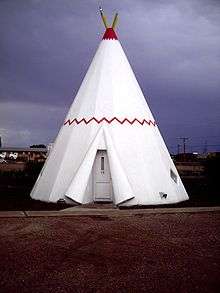 Wigwam Motel in Holbrook, Arizona (1950)
Wigwam Motel in Holbrook, Arizona (1950)- Coney Island Hot Dog Stand in Bailey, Colorado (1966)


- Large barrel-shaped bistro and bar located in Okinawa City, Japan
 At Cabazon Dinosaurs in California, this dinosaur's belly holds a souvenir shop
At Cabazon Dinosaurs in California, this dinosaur's belly holds a souvenir shop.jpg) The Big Chicken in Marietta, Georgia
The Big Chicken in Marietta, Georgia
Statues
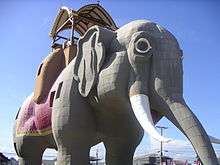 Lucy the Elephant (1881) New Jersey
Lucy the Elephant (1881) New Jersey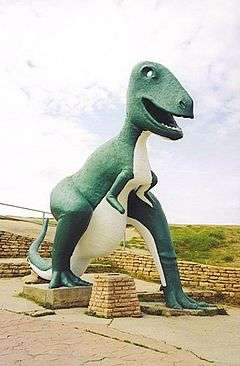 Dinosaur Park sculpture of a Tyrannosaurus rex Rapid City, South Dakota (1936)
Dinosaur Park sculpture of a Tyrannosaurus rex Rapid City, South Dakota (1936) Babe the Blue Ox at Trees of Mystery in Klamath, California (1949)
Babe the Blue Ox at Trees of Mystery in Klamath, California (1949) Golden Driller statue in Tulsa, Oklahoma (1953)
Golden Driller statue in Tulsa, Oklahoma (1953) Paul Bunyan statue in Portland, Oregon (1959)
Paul Bunyan statue in Portland, Oregon (1959)- Johnny Kaw statue in Manhattan, Kansas (1966)
 Apatosaurus statue at North Carolina Museum of Life and Science in Durham, North Carolina (1967)
Apatosaurus statue at North Carolina Museum of Life and Science in Durham, North Carolina (1967)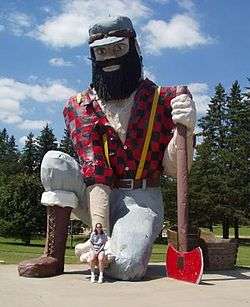 Paul Bunyan statue in Akeley, Minnesota
Paul Bunyan statue in Akeley, Minnesota- Harvey statue at Harvey Marine in Reedville, Aloha, Oregon
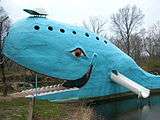
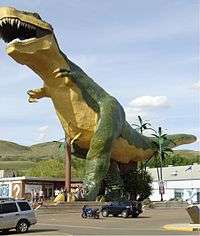
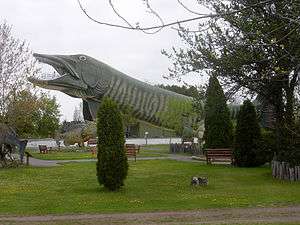 World's Largest Muskellunge in Hayward, Wisconsin at the national freshwater fishing hall of fame.
World's Largest Muskellunge in Hayward, Wisconsin at the national freshwater fishing hall of fame.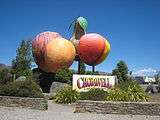 Big fruit outside Cromwell, Central Otago, New Zealand
Big fruit outside Cromwell, Central Otago, New Zealand- Kiwi fruit Te Puke, New Zealand
See also
- Australia's big things
- Ice hotels, temporary hotels made of ice and snow, found in the coldest regions of the world
- List of world's largest roadside attractions
- Muffler Men, oversized molded fiberglass sculptures used to promote roadside businesses
- New Zealand's big things
References
- ↑ Heimann, Jim (2001). California Crazy and Beyond: Roadside Vernacular Architecture. Chronicle Books. ISBN 0-8118-3018-7.
- ↑ Dinah Spritzer, "Next Stop: Glamour revives port of Batumi", New York Times, September 9, 2010.
- ↑ "Sheraton Hotels & Resorts Debuts in the Black Sea Resort Destination of Batumi", Starwood Hotels and Resorts site
- 1 2 Matthew Benjamin and Nipa Piboontanasawat (April 17, 2007). "China's mall glut reflects an unbalanced economy". The New York Times. Retrieved February 8, 2010.
- ↑ Donohue, Michael (2008-06-12). "Mall of misfortune". The National. Abu Dhabi Media Company. Archived from the original on 2011-05-01. Retrieved 2010-01-12.
Location: Dongguan, China Year Opened: 2005 Gross Leasable Area: 7.1 million square feet
- ↑ "The Not-So-Great Mall of China: Welcome to the world's largest (and loneliest) shopping centre". Daily Mail. October 29, 2009. Retrieved February 9, 2010.
- ↑ Salingaros, Nikos A. (2008). Anti-Architecture and Deconstruction (3rd ed.). Umbau-Verlag. pp. 135, 217.
- ↑ Anicic, John Charles (2005). Fontana: Images of America. Mount Pleasant, South Carolina: Arcadia Publishing. p. 83. ISBN 0-7385-2900-1. Retrieved 2011-02-06.
- ↑ "Roadside America. ''Fontana, California - Giant Orange Stand''". Roadsideamerica.com. Retrieved 2010-12-22.
External links
| Wikimedia Commons has media related to Novelty architecture. |
| Wikivoyage has a travel guide for Novelty architecture. |
- Large Canadian roadside attractions
- Roadside America: Big Coffee Pots
- The American Roadside: News and updates on America's fading roadside attractions
- Tacky Tourist Photos
